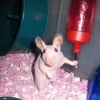This thread is part of a multi-thread series on hamster nutrition. Originally Parts I, II, III, and IV were originally written as one thread, but were split due to length. For this reason, the guide works best if the threads are read in their numbered order. However this is not strictly necessary, as each thread can stand on its own as well.
Below, you will see a listing of the different threads in the series and links to them:
[HAMSTER NUTRITION I] Nutrition, Variety, and Quality
[HAMSTER NUTRITION II] Food Mixing
[HAMSTER NUTRITION III] Calculating the Guaranteed Analysis of a Mixed Diet
[HAMSTER NUTRITION IV] Commercial Food List
[HAMSTER NUTRITION V] Safe and Unsafe Foods for Hamsters
Credits - Sincere thanks to Christmas_hamster, the creator of the original Master Food List which inspired this project. Next, nebit had an enormous role in developing, editing, and improving these threads. Finally, HoppingHammy and tbiM20 also offered tons of editing, advice, and contributions. Thank you all for your help--this wouldn't have been possible without you!
INTRODUCTION
In the previous section, we talked about nutrition, variety, and quality and why these factors are important. We also developed the idea of an "Ideal Hamster Food" based on those factors.
The ideal hamster food (for hamsters over 6 months old)...
-Has a protein level of 17% - 19%, a fat level of 4% - 7%, and a fiber level of 6% - 15%
-Has large number of whole, unprocessed ingredients in addition to pellets
-Has probiotics and prebiotics
-Does not contain large amounts of corn or other filler
-Does not contain added sugars, artificial dyes, BHA / BHT / ethoxyquin
It sounds simple enough, but there is a major problem.
There is no commercially available hamster food that matches the above description. The ideal hamster food simply does not exist at this time.
Now, there are a very few select foods that come very, very close (Burgess, Versele Laga). If these foods are available to you, they are definitely something to look into. That said, they aren't perfect, so even those with access to these foods might benefit from the ideas in this article. And those who cannot access them are going to need an alternate solution.
LAB BLOCKS, SEED MIXES, AND THEIR ISSUES
We're going to take a detour for the moment to talk about the two different types of hamster food. Every hamster food available can be categorized as either a "lab block" or a "seed mix." The difference between these two types of foods is actually very simple:
Lab blocks (aka pellets, kibble, nutrient blocks) - Contain only pellets
Seed mixes (aka muesli) - Contain pellets AND other ingredients (always seeds, but sometimes nuts, fruits, vegetables, and insects)
Lab blocks are an excellent and stable source of nutrition. However, the problem with them is that they have no variety. This is just inherent in their nature. By definition, lab blocks cannot have any variety because they are made only of pellets.
Seed mixes contain variety, but often lack proper nutrition (particularly protein). This isn't to say that seed mixes can't have proper nutrition - it's just that the vast majority of them don't. The "close-to-ideal" foods mentioned earlier are seed mixes with acceptable nutritional levels, which is a rare thing. However, I'll note again that these foods should not be considered ideal or perfect. They do have other weaknesses, such as only modest variety and artificial dyes.
In most cases, neither a seed mix nor a lab block can be fed alone. Feeding a seed mix alone will often result in a lack of nutrition. Feeding a lab block alone will result in a lack of variety.
How do we overcome this problem?
FOOD MIXING - WHAT IS IT?
Because of the lack of a perfect hamster food, many hamster owners choose use a method we call "food mixing." Food mixing is feeding multiple varieties of commercial hamster food (a lab block and a seed mix) mixed together in a particular way.
Food mixing typically involves combining a lab block with a seed mix. If you consider what we talked about above, it makes perfect sense. The lab block provides the nutrition that the seed mix lacks, and the seed mix adds the variety that the lab block lacks. The two types of food compliment each other.
As a note, one thing that cannot be fixed by mixing is extremely low quality. This is a major reason that low quality foods need to be avoided entirely.
"COMPLICATED AND UNNECESSARY"?
Food mixing is, as far as I know, a relatively new concept in hamster care. There has been some criticism of it, mostly along the lines of it being overly complicated and unnecessary. I'm sure there are many owners who wish we could go back in time to when it was considered okay to feed just one type of food.
However, I would argue that hamster care is just catching up to a lot of other animal care in this regard. Feeding multiple types of food isn't really that unusual - lots of other pets require some type of "mixed" diet. Guinea pigs and rabbits need pellets, hay, and fresh vegetables. Chinchillas need fresh hay and pellets as well. The vast majority of birds need different types of foods in their diets. Horses need grains along with hay and grass. Bearded dragons need vegetables and insects. Even animals like dogs and cats get wet food or raw food along with dry kibble. The list goes on and on.
For most other pets, feeding isn't as simple as buying a single bag of food at the store. Why are hamsters considered any different?
As far as it being complicated, it really doesn't have to be. You can easily make a great diet from only 2 foods...if you're willing to buy the best out there. It only becomes super-complicated when owners are unwilling or unable to switch from their current diet. Because then we have to work around less-than-ideal foods. Which is still possible, of course, but it does complicate things.
Think about it in terms of human foods. Cooking a healthy meal from fresh ingredients is more complicated than ordering a pizza. But at the end of the day...which one is going to be healthier?
Food mixing is important and necessary for a healthy and species-appropriate diet.
APPROPRIATE MIXING STRATEGIES
Balancing
As mentioned above, the whole point of mixing foods is to balance the weaknesses of one food with the strengths of another. It’s important to pay attention to what you’re trying to accomplish.
If you need to boost protein, you need to mix your low-protein food with a high-protein food, not one with an equally low level of protein. If you need to lower fat, you need to mix your food with a lower-fat food, not one with a similar amount of fat. If you need to boost variety, you need to choose a food that has more and different ingredients than the one you are currently feeding.
When mixing, you have to pay attention to all the factors of a proper diet, not just the one you’re trying to alter. If you’re trying to boost protein, you still have to make sure you aren’t pushing fat or fiber out of acceptable ranges.
Measuring
When mixing food, it needs to be weighed out (for example, in grams, kilograms, ounces, or pounds). Volumetric measurements (cups, tablespoons) and approximations (number of pieces) are not appropriate methods.
Volume is only useful for measuring liquids. Solids have different densities, and therefore need to be weighed.
For example, a tablespoon of Oxbow pellets and a tablespoon of Mazuri pellets. They are the same volume of food (1 tablespoon), but they are two completely different weights. This is because Mazuri is so much heavier than Oxbow. So 1 tablespoon of each food is not a 50/50 mix, as so many would assume.
Calculating
There are many safe foods that hamsters can eat, as detailed in the
Safe and Unsafe Foods for Hamsters list. Adding simple, whole ingredients is an important facet to creating an appropriate diet. These ingredients will be referred to as “extras” for simplicity.
An extra is defined as anything fed that is not sold as an actual, complete hamster diet. Extras include insects, seeds, fruits, vegetables, and so on. Put another way, "extras" are basically healthy treats.
Although extras are great, they must be limited. The majority of a hamster’s diet needs to be a fortified, complete food. Having too many extras will unbalance the diet, which can cause a number of health issues. As a rule of thumb, extras should be no more than 20% of the diet.
Variety boosting
Boosting a diet’s variety is the most obvious reason for adding extras. This allows the hamster to get flavors and textures that are not available from a dry mix alone (for example, fresh fruits and vegetables). However, since extras should only be 20% or less of the diet, you cannot rely on extras to add variety to an otherwise plain diet.
Nutritional boosting
It is not recommended to use extras to nutritionally boost a mix on a permanent, significant basis. A hamster’s main diet needs to be nutritionally solid before any extras.
For example, take high-protein extras. Adding these extras to increase variety or offer a slight boost to a complete diet with already good protein levels is fine. However, it’s not appropriate to use protein supplements to try to boost a low-protein main diet up to suitable levels.
To effectively modify the nutrition of the food, you have to calculate exactly what and how much is being added (by weight). It’s not a matter of feeding a few mealworms a couple times per week—that’s not sufficient to reliably alter nutrition. You would have to weigh out the mealworms and the serving of diet and figure out how much protein that serving was adding. Alternately, you would have to add a significant amount of mealworms to the diet itself, but this still has to be carefully calculated.
Also, if tons of extras are being fed to boost protein…that means that the hamster can’t have any fresh vegetables or other extras (because that would mean too many extras total).
Edited by Taxonomist, 28 January 2018 - 11:46 PM.






































